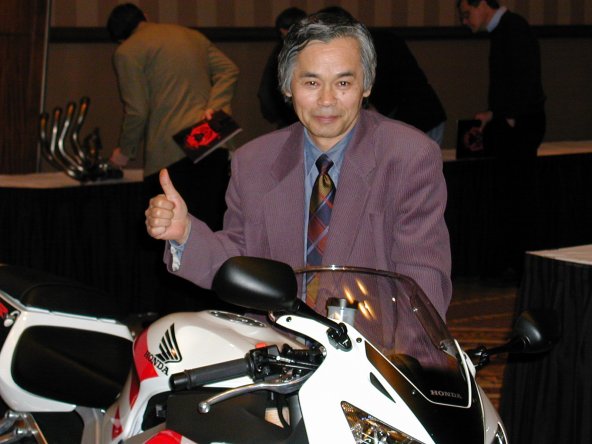 |
| Chief Designer/Engineer Tadao Baba behind his latest creation in Las Vegas |
It’s 10:15pm and I am sitting in a Las Vegas, Nevada hotel room after having spent the evening with Honda representatives, including the legendary engineer Tadao Baba, discussing the technical aspects of the 2000 Honda CBR929RR.
Tomorrow we ride the 929RR at Las Vegas Motor Speedway, home of former World Champion Freddie Spencer’s riding school (Freddie is here, by the way). Today, however, was filled with talk and anticipation. I achieved one of my goals for this trip, which was to discuss technical aspects of the 929RR with Mr. Baba himself.
Among other things, we discussed the very interesting, and innovative, intake and exhaust system. This system incorporates a flapper valve in the much larger airbox which works in conjunction with the three-position titanium valve incorporated in the exhaust system. Although I am too tired to discuss the details of this system this evening, suffice to say Honda claims a much broader spread of power by, in effect, having three exhaust systems in one to optimize low end, midrange, and high-end power output.
The numbers quoted by Honda this evening are indeed impressive. 150 bhp at 10,500 rpm and 76 ft/lb of
torque at 9,000 rpm. When asked, Mr. Baba confirmed that the torque curve is very flat as a result of the
innovative intake and exhaust.
California fans will be happy to know two things about the new 929RR. First, power output is 149 horsepower and 75 ft/lb of torque (in each instance, just one fewer than the 49-state model). Second, the California engine is internally identical with the only changes contained in the exhaust system rearward of the titanium exhaust valve in an un-boltable section of the tailpipe leading to the muffler. This section is also responsible for the approximate 5 pound greater weight of the California model. Unfortunately, when I suggested to Mr. Baba that some California owners might replace this section of the exhaust with an aftermarket unit in order to lose weight (for closed course use only – of course), he indicated that the fuel injection mapping is also different for California and the bike would not run properly. This would mean a trip to an Arizona or Nevada dealership to purchase a 49-state computer chip.
Since other technical aspects of the 929RR have been beaten to death in the press already, I wanted to discuss a couple of things that struck me during tonight’s presentation. First of all, the 929RR has killer headlights. For those of you who ride at night (and ride rapidly), the three bulb system on the 929RR will be a godsend. Each of the three bulbs is a 55-watt H7 bulb (one low beam and two high beam). When high beam is turned on, all three bulbs are illuminated at once. Of course, the reflectors are the latest, computer designed multi-reflector units, but, most impressive, the H7 bulbs (which replace the traditional motorcycle H4s) are 40% brighter than equivalent wattage H4 bulbs. I don’t know about you, but having, in effect, three, 80 watt bulbs lighting my way through dark roads and canyons could transform my nighttime rides.
The other point worth emphasizing is the sophistication of the fuel injection system on the 929RR. Utilizing an extremely high-pressure (50psi) system with four nozzle tips per throttle body (ie, per cylinder), Honda is able to achieve a very fine atomization of the spray and, thus, a more highly combustible air/fuel charge.
That’s enough for this evening. We’ll bring you riding impressions from the track tomorrow.





